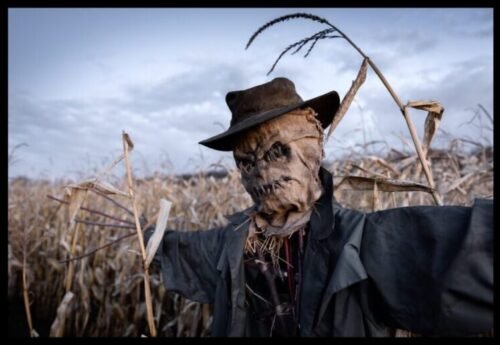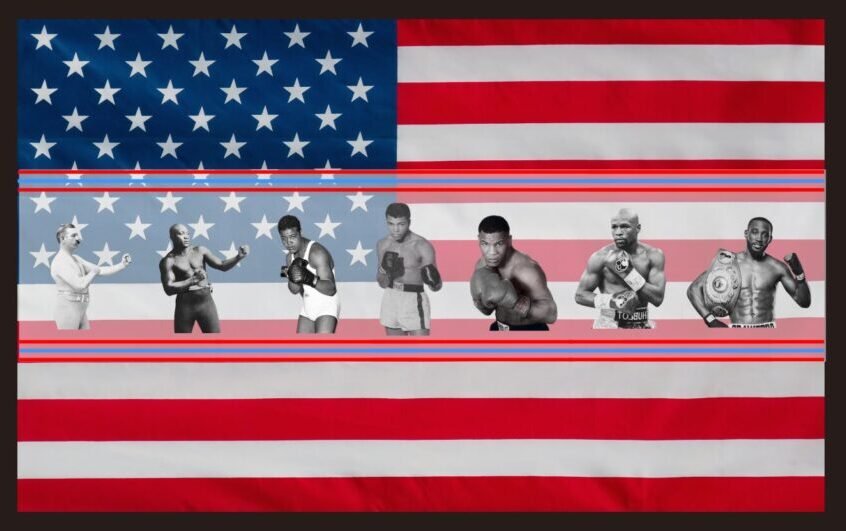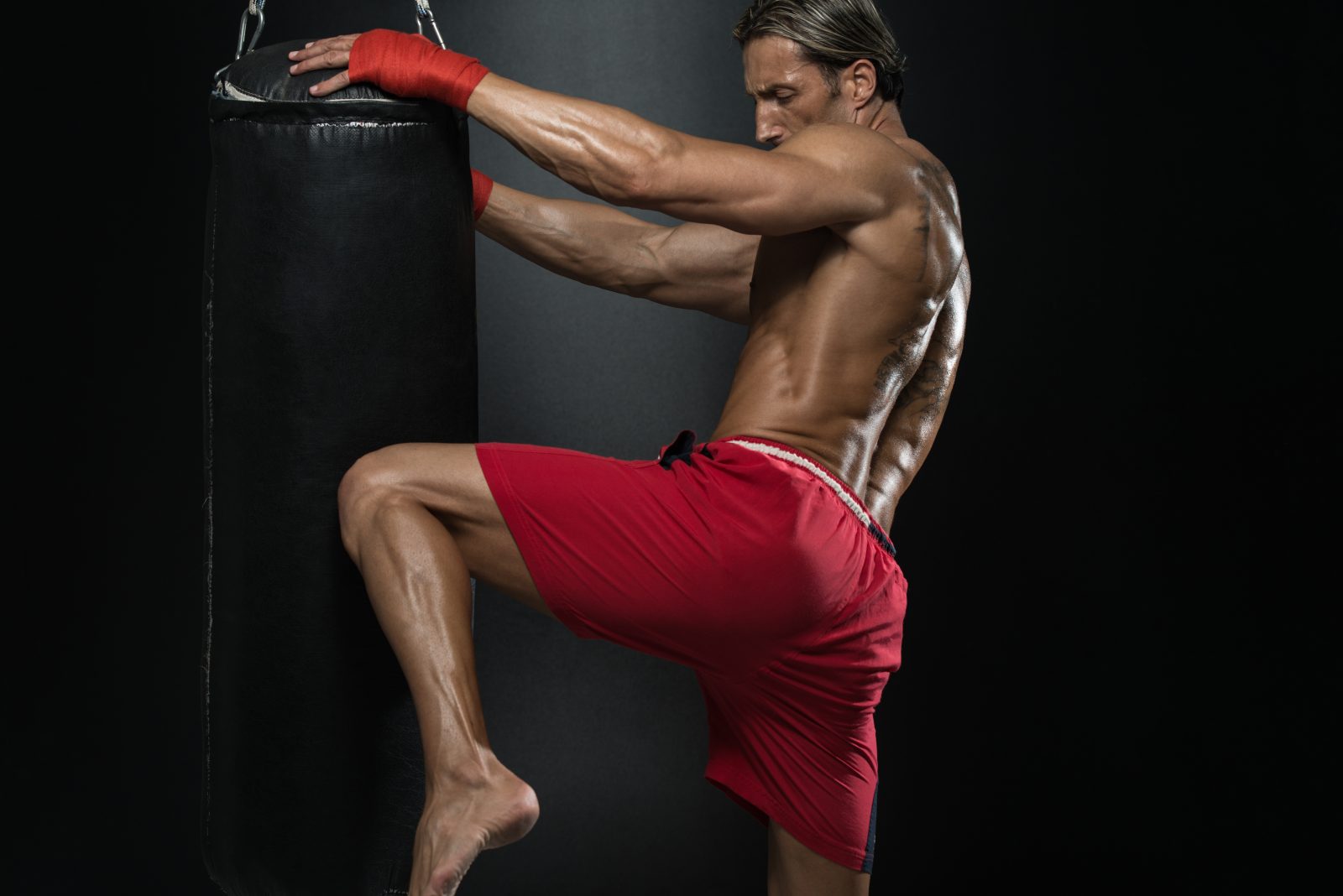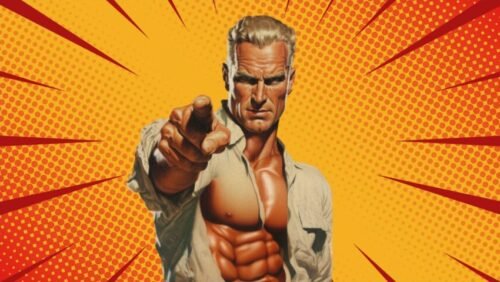From the smoke-filled fight clubs of immigrant America to Madison Square Garden and pay-per-view millions, this post looks at how the U.S. transformed boxing into both spectacle and business.
Table of Contents
🇺🇸 From Rules to Razzmatazz
If Britain gave boxing its rules and structure, America gave it a stage, a spotlight, and a storyline. By the late 19th century, boxing had crossed the Atlantic and landed in a nation obsessed with reinvention, spectacle, and upward mobility. The United States didn’t just embrace boxing — it turned it into a full-blown industry, with tickets sold, legends minted, and fists flying coast to coast.
💵 Big Business
After the Civil War, America’s booming cities became both breeding grounds and stages for boxing. In the chaos of backroom scraps and illegal prizefights, promoters spotted opportunity — and bloodsport became business. Soon the sport found its first true superstar.
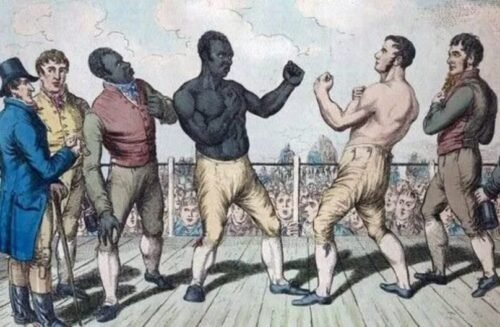
Tom Molineaux (1784–1818) – Born into slavery in Virginia, he won his freedom with his fists and fought England’s champion in 1810. His courage in the ring made him the first African American to challenge the boxing world.
Click the links below for more.
🔥 Boxing in America’s Urban Furnace
In the turn-of-the-century fight clubs of immigrant America, boxing thrived in a pressure cooker of labourers, ambition, and survival. From backroom saloons to warehouse halls and dockside pits, the fights were often illegal and brutal, run by gangs, ward bosses, and hustling promoters. The crowds were rough, the rules flexible, and the violence spectacular.
Even in the chaos, America saw potential. Promoters learned to turn blood into box office, casting fighters as heroes or villains and selling their backstories through posters and press. Local newspapers fanned rivalries, betting flowed, and crowds grew. The ring became more than combat — it was theatre, identity, and rebellion. In a country built on reinvention, boxing became one of its first modern industries.
⛓️ From Slavery to the Ring
Boxing was one of the few arenas where Black fighters could show strength and defiance in a world that denied them freedom. During slavery, brutal, coerced fights were staged on plantations — enslaved men forced to fight for their owners’ amusement and profit. Some turned that same brutality into liberation. Tom Molineaux, born into slavery in Virginia, won his freedom through the ring and in 1810 crossed the Atlantic to face Tom Cribb for the English title. Though defeated, he proved an African American could stand with the best.
His struggle paved the way for others. Peter Jackson, the “Black Prince,” ruled the heavyweights but was barred from title shots, while Jack Johnson finally broke the colour line in 1908, becoming the first Black heavyweight champion and sparking both pride and fury across America. These men weren’t just fighters — they were symbols of resistance whose courage turned boxing into a fight for identity, respect, and equality.
🌟 John L. Sullivan – The First Boxing Superstar
No one embodied boxing’s transformation like John L. Sullivan, the self-proclaimed Boston Strong Boy. He was both the last bare-knuckle heavyweight champion and the first under the Queensberry Rules — a bridge between eras — fists clenched, moustache bristling. Touring America by rail, he offered cash to anyone who could last four rounds. Few did.
Sullivan was more than a bruiser — he was boxing’s first celebrity. Newspapers followed his every move, crowds filled halls to see him fight, and promoters learned that personality sold as well as power. His swagger and showmanship turned boxing from spectacle into business.
His 1889 war with Jake Kilrain lasted 75 rounds — the last bare-knuckle title fight in history. With that, Sullivan closed one age and began another: bare fists were out, gloves were in, and boxing was now a national obsession.
From the smoke-filled halls to Sullivan’s 75-round epic, boxing in America had outgrown its backroom roots. The age of the prizefighter had arrived — no longer a hidden brawler but a national icon. Then came a new kind of ring: the airwaves, as immigrant America filled the gyms and the nation tuned in.
🌍 A Gateway for Immigrants and the Underclass
No sport mirrored the American experiment quite like boxing. In a land of upheaval and ambition, the ring became a proving ground for the dispossessed — a brutal shortcut to pride, purpose, and respect. Every wave of immigration brought a new fighting class, each viewing the squared circle as a shot at redemption and identity.
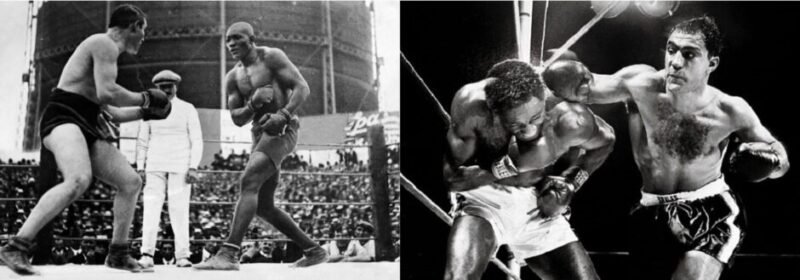
Immigration shaped the American fight game — from Jack Johnson breaking colour barriers to Rocky Marciano rising from Italian roots, boxing became the proving ground for outsiders chasing respect and glory.
Click the links below for more.
🍀 Irish-Americans
In the 1800s, it was the Irish who first made their mark — brawling their way out of slums and saloons to carve space in a hostile, Protestant-dominated America. No group embodied the grit of early immigrant boxing more. At the front stood John L. Sullivan, the “Boston Strong Boy,” whose rise from those same rough streets to national superstardom made him both a symbol of Irish toughness and America’s first boxing icon.
But he wasn’t alone — Irish fighters filled the prize rings of New York, Boston, and beyond, turning bare-knuckle brawls into a pathway out of poverty. For a people scorned by “No Irish Need Apply” signs, the ring became both weapon and refuge — a place where fists could win the respect society denied them.
✡️🥊 Jewish Fighters
From the 1910s to the 1930s, Jewish boxers like Benny Leonard, Barney Ross, and Abe Attell ruled weight divisions with skill and finesse. Leonard, “The Ghetto Wizard,” was admired for his intelligence in the ring, elevating boxing beyond brute force. These fighters carried the hopes of Jewish immigrant communities crammed into New York’s Lower East Side, proving that brains, precision, and courage could overcome prejudice. For Jewish fans, every victory was a cultural win against antisemitism, poverty, and exclusion.
🇮🇹 Italian Fighters
By the 1930s and 40s, Italian-Americans stormed the fight game, their names etched into boxing folklore. Rocky Marciano, the only undefeated heavyweight champion in history, became a blue-collar hero for millions. Jake LaMotta, the “Raging Bull,” fought with raw ferocity, his life later immortalised on film. Tony Canzoneri and Rocky Graziano brought grit, flair, and working-class swagger into the spotlight. For Italian immigrants, who faced poverty and prejudice of their own, the ring was both an escape and a stage. Victory was family honour, neighbourhood pride, and proof that tough men from tenements could rise to greatness.
✊🏿🌍 African-American Fighters
Then came the African-American greats, who entered the ring under a weight far heavier than gloves. Jack Johnson’s dominance sent tremors through Jim Crow society, his swagger and defiance seen as dangerous rebellion. Joe Louis, by contrast, was held up as a humble patriot — but behind his quiet strength was a fighter uniting Black and white America in the shadow of World War II. And then there was Muhammad Ali, who turned the ring into a pulpit — refusing the Vietnam draft, mocking white supremacy, and proving that a boxer’s voice could shake governments.
🇲🇽🇵🇷🇨🇺 Latino Fighters
By the mid-20th century, Latino fighters reshaped American boxing. Champions from Mexico, Puerto Rico, and Cuba brought relentless heart, rhythm, and precision. Icons like Julio César Chávez, Wilfredo Gómez, and Teófilo Stevenson became cultural beacons, linking barrios and gyms across borders. Their influence kept the sport’s spirit alive in every major fight city.
In every era, boxing wasn’t just a sport — it was a weapon against marginalisation, a stage for civil resistance, and a fist in the face of discrimination. The ring didn’t care where you came from — but it would make the world care once you stepped inside it. In that squared circle, immigrants, outcasts, and underdogs found the fastest route to dignity — and sometimes, to glory.
📻📺 Mass Media: The Power Behind the Punch
As boxing entered the 20th century, it wasn’t just fists that forged legends — it was the microphone and the camera. America turned the sport into mass spectacle, first through radio, then television, and later the Pay-Per-View boom. Each new medium amplified the drama, carrying the sounds and sights of the ring into homes, bars, and stadiums, transforming prizefights into national — sometimes even global — events.
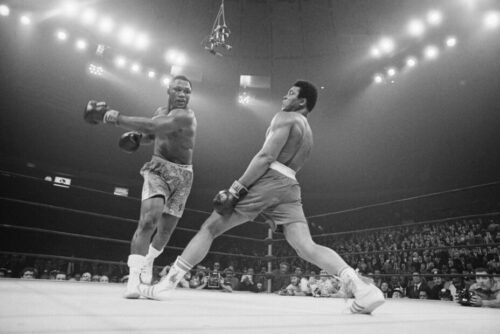
Ali vs. Frazier I, the Fight of the Century (1971) — more than a clash of two undefeated champions, it was a battle of ideals, politics, and pride that split America and defined an era.
Click the links below for more.
🎙️ From Radio Rituals to TV Spectacle
Boxing found its voice in the age of broadcast. The first live radio broadcast crackled across America in 1921, and by the 1930s, fight nights were national rituals. Radios blared in bars, living rooms, and fire escapes as the country gathered around a shared sound — leather on flesh, the roar of the crowd, the announcer cutting through the static.
Then came television, and with it, boxing’s golden era of spectacle. By the 1950s, boxing wasn’t just on the air — it was in your home. Fights were broadcast coast-to-coast, turning local champions into household names.
📉 Economic Depression & Boxing Boom (1930s)
During the Great Depression, fight nights were escape valves for the working class. Joe Louis stood as proof that a man with nothing could still stand tall under the lights — hope in gloves when the banks had none. In an age of breadlines and broken banks, the boxing ring became a sanctuary, where hope came with gloves and courage could still change a man’s life.
⚡ When the Ring Shook the World
Some fights went beyond sport—they became national flashpoints.
- Joe Louis vs. Max Schmeling II (1938) wasn’t just a rematch — it was a symbolic blow against fascism on the eve of war.
- Ali vs. Frazier I (1971), the “Fight of the Century,” was a collision of politics, race, and ego — two undefeated giants in a nation tearing at the seams.
- Teófilo Stevenson vs. Duane Bobick (1972) carried that tension onto the world stage — a Cuban heavyweight dismantling an American hope in a Cold War crucible. For once, ideology, not money, decided the winner.
- Don King redefined promotion itself, transforming fights into global theatre — complete with showgirls, stadium lights, and Cold War undertones.
🪖 Gloves Across the Globe — America’s Military Export of Boxing
Just as Britain spread boxing through its empire, America exported it through its 20th-century military reach. During and after WWII, U.S. soldiers boxed on bases from Europe to the Pacific, bringing with them the fast, aggressive, media-driven American style.
From Berlin to Tokyo, Korea to Saigon, the sport followed the troops — military gyms became schools, while USO (United Service Organizations) tours kept morale high with bouts and exhibitions.
Together with Hollywood and radio, that pipeline exported not just technique but the mythology of the American ring. If the microphone carried boxing into living rooms, the military carried it across oceans — GI gloves spreading the American style wherever the flag flew.
🕶️ 🏟️ The Pay-Per-View Revolution
By the 1980s, cable TV and Pay-Per-View changed the game. No longer just for the masses, boxing became exclusive—premium, packaged, and profitable. Fighters like Mike Tyson turned knockouts into prime-time spectacles. Oscar De La Hoya brought crossover charisma. And Floyd Mayweather perfected the business model, turning defensive brilliance and pre-fight hype into hundreds of millions.
The ring had become a stage—and America, its loudest and most lucrative audience.
💀 The Dark Side of the Deal - Gambling, Crime, and Corruption
For every underdog story and sold-out arena, there was a shadow in the rafters. Boxing’s boom in America wasn’t just built on sweat and fists — it was bankrolled by backroom deals and underworld money. The fight game was never just about glory; it was a gamble where the house was often run by gangsters.
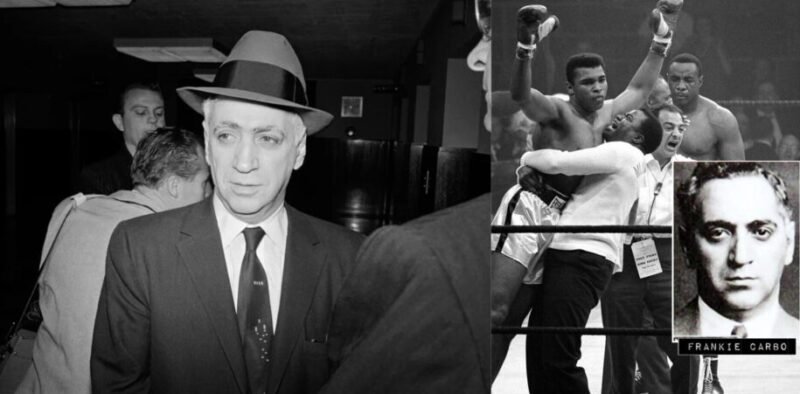
Ali’s stunning win over Sonny Liston in 1964 didn’t just crown a new champion — it symbolised the end of Frankie Carbo’s mob grip on boxing, breaking the old order and ushering in a new era.
Click the links below for more.
😈 Dancing with the Devil
For all its glory, American boxing has always danced with the devil. The same allure that drew crowds and cash also attracted the underworld. By the 1920s, organised crime had its hooks in the sport — rigging outcomes, controlling fighters, and laundering dirty money through big-name bouts. Mobbed-up managers handled prospects like commodities, trading influence behind closed doors while the crowds roared ringside.
🏙️ Cities of Corruption
Chicago and New York became hotbeds for corruption. Fights were fixed, decisions sold, and champions muzzled by fear or favour. But no figure loomed larger in boxing’s shadow realm than Frankie Carbo — a former hitman turned power broker. Running the International Boxing Club as his front, Carbo blurred the line between gangster and promoter, his power stretching into every corner of the fight game.
⚖️ Crackdown and Courtrooms
By the 1960s, the mob’s empire began to crack. Senate hearings dragged managers, promoters, and even fighters into the spotlight, exposing how deep the rot ran. Frankie Carbo and Blinky Palermo went to prison — the mob lost its crown, but not its shadow.
Three decades later, new hearings found the same game under new names — bad contracts, fake rankings, fighters broke after title bouts. Congress answered with the 2000 Muhammad Ali Act, meant to clean house. On paper it worked; in practice, the sharks learned to swim around it.
As the mob’s grip weakened, a new kind of control emerged — not from gangsters, but from government halls and athletic commissions.
🏟️ Venues, Commissions, and Organised Chaos
Boxing might have been born in backrooms and alleys, but by the 20th century it demanded order. As money poured in, the sport could no longer survive on chaos alone. Rules had to be written, titles recognised, and stages set. What followed was a patchwork of authority — sometimes protective, sometimes corrupt — that shaped the fight game into both business and theatre.
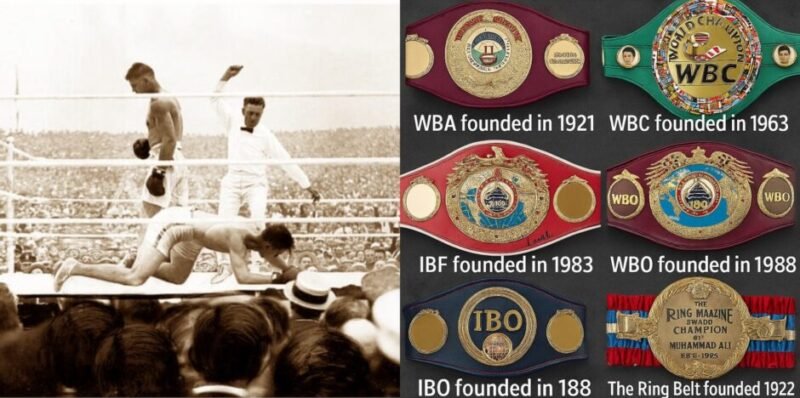
The 1921 clash between Jack Dempsey and Georges Carpentier, sanctioned by the newly formed National Boxing Association (later WBA), marked the rise of world bodies and championship belts — turning fights into global events with lasting legitimacy.
Click the links below for more.
⚖️ States Step In – The Rise of Athletic Commissions
As boxing ballooned into big business, some attempt at order had to follow. To curb the chaos and silence critics, state athletic commissions emerged — chief among them New York, California, and Nevada. These bodies oversaw fighter licensing, enforced fouls, mandated medicals, and acted (in theory) as ethical referees behind the scenes. It was still a brutal sport — but now there were contracts, suspensions, and consequences. The ring had rules.
🌍 Belts and Bureaucracy – The Sanctioning Body Era
On the global stage, however, regulation splintered. The WBA (1921) came first, followed by the WBC (1963), IBF (1983), and WBO (1988) — each claiming authority, each crowning its own champions. What began as attempts to organise the sport soon descended into alphabet soup. Multiple belts, conflicting rankings, and shady politics turned title paths into labyrinths. Unification became a rarity. Still, these sanctioning bodies lent boxing an international framework and helped ignite global rivalries that brought new blood to the sport.
⛪ Cathedrals of the Fight Game
Amid the bureaucracy, legendary venues became boxing’s cathedrals. Fights weren’t just contests—they were spectacles held on hallowed ground:
- Madison Square Garden (New York) — The Mecca of boxing, where icons were forged under blinding lights.
- Caesars Palace & MGM Grand (Las Vegas) — The neon colosseums of the fight game, where risk met reward in million-dollar bouts.
- Boardwalk Hall (Atlantic City) — Grit and glitz fused on the Jersey Shore, giving rise to East Coast rivalries and underdog stories.
In these arenas, the sport transcended blood and belts. It became ritual, drama, and theatre—a world where myth and money met centre ring.
Together, these commissions, bodies, and venues gave boxing its framework. They tamed the brawls just enough to sell tickets, yet left enough chaos to keep the crowds coming back. In the end, the fight game was never truly controlled—it was staged, sanctioned, and sold.
🎆 The American Boom
By the mid-20th century, boxing in America exploded into a cultural juggernaut. Fighters weren’t just champions — they were symbols of eras, voices of communities, and avatars of national mood. From the Olympic stage to Pay-Per-View superstardom, the U.S. didn’t just dominate the sport — it defined what boxing meant in the modern age.
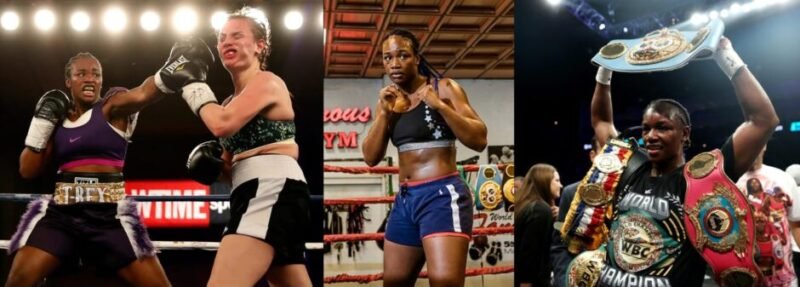
From Olympic gold to world titles, Claressa Shields embodies the rise of modern women’s boxing.
Click the links below for more.
🎆 Fighters Who Defined an Era
As the spotlight grew brighter, the stories got bigger. By the mid-20th century, boxing in the U.S. had transcended sport — it had become narrative. Each fighter embodied an era:
- Jack Dempsey – The violent, roaring 1920s.
- Joe Louis – Wartime unity and racial progress.
- Muhammad Ali – Civil rights, defiance, and global stardom.
- Mike Tyson – Raw talent, chaos, and media saturation.
But America’s dominance wasn’t just forged in the pro ranks. It began in the amateur system, especially the Olympic pipeline. Fighters like Louis, Ali, Leonard, and De La Hoya earned their stripes under the national spotlight before conquering the global stage. The Team USA gym became a crucible — a forge where talent met structure, and where pride in country fuelled dreams of greatness.
♀️🥊 Women Enter the Ring
While other nations resisted change, America opened the door. In 1979, the U.S. hosted the first Women’s World Boxing Championship, paving the way for female fighters to train, compete, and rise through the ranks. Trailblazers like Christy Martin and Laila Ali turned heads, drew crowds, and proved the ring wasn’t just a man’s domain. America didn’t just build boxing’s stage — it widened it. Decades later, fighters like Claressa Shields, Katie Taylor, and Amanda Serrano carried that legacy into the modern era, turning what began as defiance into dominance.
🎬 Cultural Exports & Film
Hollywood immortalised the ring’s mythology. From Raging Bull’s tortured artistry to Rocky’s underdog dream and Creed’s modern revival, boxing became America’s mirror — a canvas for pain, pride, and perseverance.
On screen, as in life, the fighter’s story reflected the nation itself: struggle, redemption, and the endless pursuit of greatness.
🇺🇸✨ American Archetypes – Legends in the Making
Beyond belts and medals, America exported the mythology of boxing. It wasn’t just about who won — it was about the stories. The underdog’s rise, the dramatic comeback, the one-punch redemption. America built fighters into characters, then into legends, creating a blueprint the world would follow.
At its heart, the formula was simple:
Talent + Spectacle = Immortality.
🧠 Archetypes of the American Ring
- The Gritty Underdog – Rocky Balboa types, real or imagined.
- The Brash Showman – From Ali to Mayweather, charisma became a weapon.
- The Silent Killer – Tyson, Hagler—let fists do the talking.
- The Ethnic Hope – Carried the pride and burden of entire communities.
From Dempsey’s haymakers to Ali’s words, from women breaking barriers to archetypes that still shape fight promotion today, America turned boxing into story as much as sport. The American boom was never just about titles—it was about identity, theatre, and myth. And for better or worse, it set the standard the rest of the world would chase.
🏙️ The Fight Cities – America’s Boxing Strongholds
Boxing in the U.S. has always been a city sport. Gyms, neighbourhoods, and arenas became crucibles, each stamping fighters with their own style — grit, speed, flair, or spectacle. These strongholds turned local heroes into national icons and kept America at the centre of the fight game.
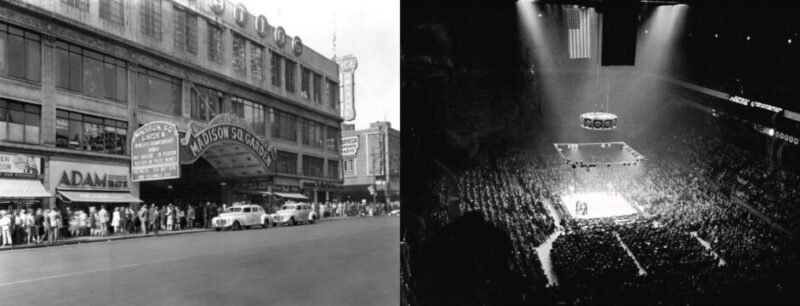
As boxing grew into mass entertainment, venues like Madison Square Garden became its grand stage — transforming fights from smoky halls into stadium spectacles where legends were made under the lights.
Click the links below for more.
🗽 New York City – The Mecca of Boxing
- Home to Madison Square Garden, boxing’s cathedral.
- Legendary gyms like Gleason’s bred generations of champions.
- Produced tough, technical fighters from Brooklyn to the Bronx.
🦅 Philadelphia – The City of Toughness
- Known for brutal gym wars and the famed Philly Shell defence.
- Birthplace of Joe Frazier.
- Fighters earned respect the hard way—through blood and bruises.
🚗 Detroit – The Motor City Machine
- Home of Kronk Gym and trainer Emanuel Steward.
- Produced “punchers with polish” like Thomas Hearns.
- Mixed power, speed, and ring IQ.
🌴 Los Angeles – West Coast Warriors
- Epicentre for Mexican-American boxing.
- Venues like the Olympic Auditorium were weekend battlegrounds.
- Trained global stars like De La Hoya and Chávez Jr.
🎰 Las Vegas – The Neon Fight Capital
- From the 1980s on, it became boxing’s main stage.
- Caesars Palace and MGM Grand hosted mega-fights.
- Where money talks, legacies are made, and lights never dim.
🍀 Boston – Cradle of the Irish Fighter
- Early boxing hub, dominated by tough Irish-American fighters.
- Hosted some of the first regulated bouts in the U.S.
- Produced rugged brawlers who fought with grit and fire.
🌬️ Chicago – The Windy City Warriors
- A city of mob influence and heavyweight drama.
- Classic fight nights defined the golden era.
- Known for producing bruisers with heart.
From coast to coast, each city forged its own rhythm — its own way to fight. Out of those neighbourhood rivalries came something deeper: a national style.
🥊 The American Styles – Schools of the Ring
American boxing was never a single style — it was a patchwork of gym-born traditions. Each city and trainer created their own blueprint, shaping fighters who carried those systems into the ring. From defence-heavy craftsmen to explosive pressure fighters, the United States became a laboratory of styles that influenced boxing worldwide.
- The Philly Shell (Philadelphia) – A defensive masterpiece popularised by George Benton, used by James Toney and Floyd Mayweather Jr. Shoulders, angles, and patience turned defence into offence.
- The Peek-a-Boo (New York, Cus D’Amato) – Head movement, tight guard, and explosive counters, famously moulding Mike Tyson into a whirlwind of pressure.
- Mexican-American Pressure (Southwest) – forward-marching aggression fused with US gym systems, seen in East LA and Oxnard standouts like Oscar De La Hoya, Leo Santa Cruz, Brandon Rios, and Mikey Garcia.
- Detroit’s Kronk Style – Emanuel Steward’s Kronk Gym bred devastating punchers (Hearns, Hilmer Kenty), built on range control and ferocious straight rights.
- West Coast Speed & Slickness (LA & SoCal gyms) — fast hands, rhythm, and polish—embodied by Oscar De La Hoya, Shane Mosley, and Fernando Vargas.
From Philly basements to Detroit warehouses, U.S. gyms forged systems that influenced the entire boxing world.
🧠 The Architects Behind the Gloves – Trainers & Gyms
Every champion may wear the crown, but it’s the gyms and trainers that forged the steel. From sweat-stained rings to legendary corners, American boxing’s soul has always been built in the gym, where trainers shaped raw hunger into fighting legacy.
🧩 🥊 The Minds That Built Champions
Behind every legendary fighter stood a craftsman of violence—a trainer who refined raw talent into championship pedigree. American boxing was shaped in sweat-stained gyms like Kronk (Detroit), Gleason’s (NYC), and the 5th Street Gym (Miami). These weren’t just training halls — they were schools of survival.
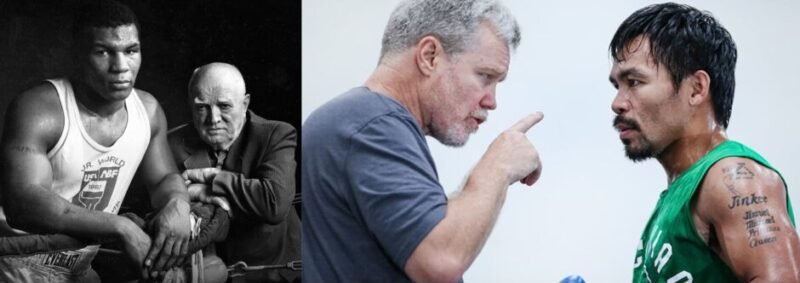
Great fighters are forged in great gyms. Cus D’Amato shaped Tyson’s raw aggression into controlled chaos, while Freddie Roach refined Pacquiao’s speed into surgical precision — proving trainers can be as influential as the champions themselves.
Names like Cus D’Amato, Angelo Dundee, Eddie Futch, and Freddie Roach became icons in their own right — not just coaches, but tacticians and mentors who turned fear into focus and talent into legacy. D’Amato didn’t just teach Tyson to punch—he taught him to harness fear, weaponise discipline, and walk into the storm without flinching.
In American boxing, the gym was the science lab. The trainer? The alchemist. They turned poverty into purpose, chaos into clarity, and fists into folklore.
🏛️ The Legacy of American Boxing
The U.S. turned a codified sport into a cultural juggernaut — equal parts business, theatre, and battleground. It produced the first global superstars, built gyms that became dynasties, and transformed immigrant struggle into living legend. From mob ties to Madison Square Garden; from pay-per-view millions to Las Vegas neon, America made boxing bigger, louder, and impossible to ignore.
🇺🇸 Summary — What America Brought to Boxing
🇺🇸 Boxing as Big Business — Transformed the sport into a mass-market spectacle, complete with promoters, ticket sales, and media hype
🇺🇸 The First Sports Superstars — Elevated fighters like John L. Sullivan, Jack Dempsey, and Muhammad Ali into national icons and cultural legends.
🇺🇸 Immigrant Pipeline — Provided a proving ground for Irish, Jewish, Italian, African-American, and Latino fighters to rise from poverty to glory.
🇺🇸 Fight Cities & Regional Styles — Created powerhouse hubs like New York, Philadelphia, Detroit, and Los Angeles, each with its own rhythm and fight culture.
🇺🇸 Media Domination — Harnessed radio, television, and Pay-Per-View to turn fights into global events and boxers into household names.
🇺🇸 Military Export — Spread boxing worldwide through WWII and Cold War bases — GI gloves embedding American style and storytelling across Europe, Asia, and beyond.
🇺🇸 Trainers & Gyms as Institutions — Built dynasties through masters like Cus D’Amato, Angelo Dundee, Emanuel Steward, and Freddie Roach, who shaped generations of champions.
🇺🇸 Grit & Narrative — Cemented the underdog story as the sport’s moral backbone — fighting not just for belts, but for identity, dignity, and redemption.
🇺🇸 Vegas & The Showbiz Era — Made boxing synonymous with bright lights, big money, and main-event drama.
🇺🇸 Pioneering Women’s Boxing — Hosted the first Women’s World Championship and elevated female fighters decades before many other nations.
From immigrant ghettos to the Vegas strip, America took Britain’s orderly framework and supercharged it with ambition, media savvy, and raw cultural force. If Britain built the skeleton of modern boxing, America gave it muscle, personality, and a booming voice.
If you have enjoyed this post please share or feel free to comment below 🙂
Related Posts
Other Posts
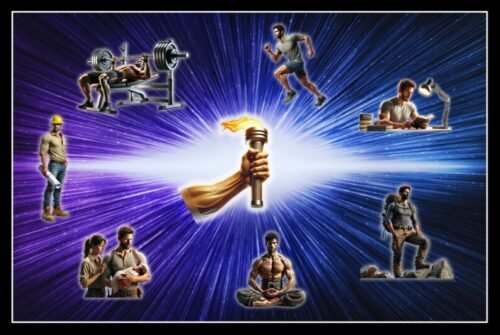
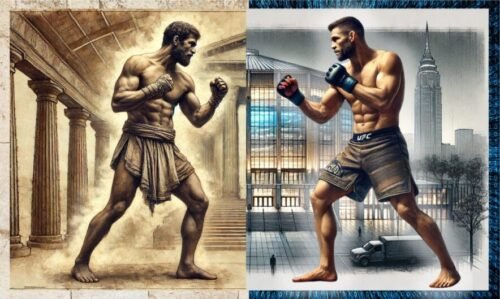
The Evolution of Combat: From Prehistory to Modern MMA
🔥 Join us on an immersive journey through 12,000 years of martial evolution—spanning continents, cultures,
